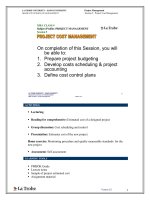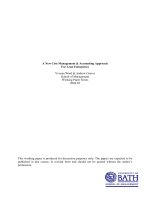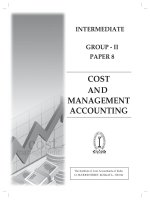Cost management training section1 wquiz answers
Bạn đang xem bản rút gọn của tài liệu. Xem và tải ngay bản đầy đủ của tài liệu tại đây (2.6 MB, 89 trang )
DASA-CE Training
Cost management 101
Who are We?
COMMAND SITE SMEs: Command Site resources identified in some manner to provide subject
matter expertise and information for a GFEBS related effort (e.g. Supervisors, Users, etc.)
COMMAND
COMMAND
SITE
Cost
SMEs
Team
COMMAND COST TEAM: Command HQ resources identified to support the deployment of Cost
Management functionality within the new applications, e.g. GFEBS, GCSS-A. (Not every command
has a specific Cost Team)
DASA-CE COST TEAM: A specialty group supporting Army Commands in the transformation to a
“Cost Culture” utilizing ERP tools (e.g. GFEBS, GCSS)
DASA-CE
Provides Cost Management (CM) Training
Assists Commands in defining Cost objectives
Provides CM Capture Teams to develop CM Master Data with sites and then provided to
GFEBS
Cost
Team
GFEBS: Various teams focusing on specific objectives in order to make the overall program a success
GFEBS
- Deployment
- Training
-O&S
- Site Support
2
DASA-CE Cost Mission
Enable the Army in Transitioning to a Cost Culture utilizing ERP applications (e.g. GFEBS, GCSS, etc.)
1.
Define the Cost Model across the Army (HQ Design)
Identify Command Strategic Objectives (e.g. products/services)
Determine methods/mechanisms to determine Full Costs of Objectives
2.
Train Cost Concepts (approx. 12 hr Training Session)
Not specific GFEBS training on running cost transactions
Builds a language to transition from legacy to future
Aids field in understanding level of effort to perform Budget Execution vs Cost Management
Focus is on Cost Management terms, processes, structures, reporting, etc.
3
DASA-CE Cost Mission
(Continued)
Enable the Army in Transitioning to a Cost Culture utilizing ERP applications (e.g. GFEBS, GCSS, etc.) Cont’d :
3.
Support the definition and collection of master data to be loaded for cut-over into GFEBS , etc. (CM Build)
Training and supporting the “Capture Teams” – Command specific teams working in conjunction with the DASA-CE CM
team to gather all the data required for the waves
Aid with determining best approach for defining the CM master data to meet all information needs (Informal Budget, Budget
Execution, and Cost Management)
4.
Provide on-going support
Create/Change CM Master Data via requests
Identify future requirements and incorporate with GFEBS
5.
Provide Policy and Guidance
Army Cost Management Handbook
Army Cost Management Maturity Model
4
DASA-CE CM Schedule
(Macro-level)
FY2010
1
S
O
N
FY2011
2
D
J
3
F
M
A
4
M
J
J
1
A
S
O
2
N
D
J
FY2012
3
F
M
A
4
M
J
J
1
A
S
O
N
D
J
COST MANAGEMENT TRAINING
CYCLE
MOCK
CNV
WAVE 2 SE
HQ
CM
CM
DESIGN
TRNG
BUILD
CYCLE
MOCK
CNV
WAVE 3 WE
HQ
CM
CM
DESIGN
TRNG
BUILD
CYCLE
MOCK
CNV
WAVE 4 NE
HQ
CM TRNG & BUILD
DESIGN
CYCLE
MOCK
CNV
WAVE 5 PAC, EUR & AR
HQ
CM TRNG & BUILD
DESIGN
CYCLE
MOCK
CNV
WAVE 6 ARNG
HQ
CM
CM
DESIGN
TRNG
BUILD
CYCLE
MOCK
CNV
WAVE 7 NE (BRAC) & AR
HQ
CM
CM
DESIGN
TRNG
BUILD
CYCLE
MOCK
CNV
WAVE 8 Contingency (All Other)
10/31/20
5
Mission #1: Cost Model
Conceptual Design
1
2
3
Strategic Session(s)
Intro Mtg.
4
Operational Sessions
5
Confirmation
Command Pilot
Session(s)
Inputs:
Inputs:
Inputs:
Inputs:
Inputs:
•
•
•
•
•
•
•
•
•
•
•
•
•
Overview Presentation
CM Training
APC Files
TDA Files
HQ Reports
CM Training
HQ Objectives from #2
APC Files
Findings Pres. to HQ
Finalized Master Data
Data
•
Templates
GFEBS Load of Master
TDA Files
Build Allocations/
Assignments
•
OPs Reports
GFEBS Update for
Reporting Needs
Outputs:
Outputs:
Outputs:
Outputs:
Outputs:
•
•
•
•
•
•
•
•
•
•
Identified POCs
CC Structures &
Attributes
Scheduled #2/#3 Mtg.
•
•
•
Products & Attributes
Non-Fin Metrics
Attributes
•
•
Identified #3 Locations &
POCs
Δ CC Structures &
Δ Products & Attributes
Non-Fin Metric Systems
Reviewed
•
Identified Pilot Construct
•
CCs & Hierarchy
Internal Orders
WBS Elements
Command Review
Identify Areas for
Enhancement
Identify Cost Allocations
•
Resourcing Strategy for
& Assignments
Follow-on Waves, e.g.
Reports
“Capture Team”
Resources
6
Cost Model Roll-Out
Steps
1
to
6
6
Cost Mgmt Training 101
Completed
Command Roll-Out
Course Info:
Inputs:
•
•
•
Approx. 12 hrs
and how to's in GFEBS
•
•
Resource & Operational/Business Mgrs.
•
•
•
•
•
Budget vs. Costs
Cost terms/Definition
Defining CM master data structures and
uses (replaces APCs)
•
•
Different Reporting Capabilities
PASS THE EXAM!
S2L2_p
Δ/Create Products & Attributes
Non-Fin Metric Systems
Implemented
Approx. 50 per class
Learning Objectives:
Δ/Create CC Structures &
Attributes
Focus on Cost Management principles
Educate and Integrate
Command Participants
7
Outputs:
•
•
•
•
CCs & Hierarchy
Internal Orders
WBS Elements
Cost Allocations &
Assignments
•
Reports
7
What is the Costing Conceptual Design?
•
The translation of the business objectives, needs, and requirements into a management
decision support model (Cost Model)
•
•
The replacement of the legacy financial codes (APCs/JONOs-MRRNs)
“The Continuum” – maturation over years, replacing as-is, adding quantity measures,
performing cost assignments, etc.
The CCD influences/defines the set-up of tools providing cost management information, e.g. GFEBS, GCSS, Data Warehouses, etc.
8
Mission #2: CM 101 Training
CM 101 Training
Section 1: Cost Management Overview
What are costs and why is managing costs important?
Army’s overall objectives
Change enablers o support Cost Management
The process of Cost Management and how it differs from Budget Management
Section 2: Cost Model Components
Defining the various cost objects (which replace APCs/JONOs) within a Cost Model, e.g. organizations, products, services, jobs, etc.
Understanding decision points of where to capture information
Section 3: Cost Flow Methods
The difference between cost capturing, allocations, and assignment
Section 4: Cost Model Build
Reflecting organizational structures
Replacing APC/Jonos
9
Mission #3: CM Master Data Build
OUTPUT
VALIDATION
GFEBS TEAM
Conversion Team
CONVERT
DASA-CE / GFEBS
INPUT
CORRECT
VALIDATION
Consolidation Team
DASA-CE CORE TEAM
CONSOLIDATE
DATA
CORRECT
VALIDATION
Team 2
Team 1
Team 4
Team 3
CAPTURE TEAMS
Team 5
CONTROL
DATA
CORRECT
VALIDATION
COMMAND SITE POCS
DASA-CE / Army
CREATE
10
Master Data: Cost Centers
A Cost Center = Organization; which:
Incurs costs
Has a manager who is accountable for those costs
Has a long life span of more than 1 year (typically years)
Can be assigned informal budget
A Cost Center accounts for resources:
People: Ops & Maintenance, DOIM IT Support, etc.
Facilities: Warehouses, Hospitals, Office Space
Equipment: IT server farm, Cranes/Trucks
Blended: mix of resources within a organization, e.g. Vehicles and Mechanics
11
Master Data: Activity Types
An Activity Type represents a group of resources within a Cost Center. These resource groups have capacity and
a unit of measure such as: labor hours, machine hours, square footage, etc.
Activity Type Uses:
Capture Capacity or Planned Output, e.g. technician works 2088 Hrs or machine runs 3500 Hrs (10 Hrs/Day for 350 days)
Holds the rate for the output of the resource pool, e.g. $2 Hr, $5 Hr, $20 Hr
Assigns capacity consumed by products/ services, e.g. Hrs/min worked per diagnostic test, which then valuates based on the
rate
12
Master Data: Things You Do
Various other Cost Objects are used to represent the things that the Cost Centers/Orgs are providing: Internal
Orders, Projects/Work Breakdown Structures, Maintenance Orders, etc.
Internal Orders: are short term in nature, represent an event or job, do not replace the rigor of the Project/WBS Element
structure, e.g. Courses, CLS-SSPs, Pre-Deployment, Professional Certification
WBS Elements: sub-tasks within Projects used for planning, executing, and costing and managing dependencies, e.g MEDCOM
MRMC Labs projects, DPW Minor Constructions, Environmental clean-ups. Additionally, WBS Elements are used for
reimbursable work either through a MIPR or as a Direct Charge.
Business Process: Captures costs of cross-functional activities (the “work” performed by the Cost Center/Activity Types) and
typically related to an action such as a “verb”, e.g. Pick Items, Pack Boxes, Ship Pallet
13
Master Data: Things You Track
•
A Statistical Key Figure (SKF) is a piece of information about the cost object it is assigned to, e.g. # FTE for a
cost center, # telephones, # of Students in a Class, # of Ads within a Campaign
•
SKFs are used to:
•
•
•
Capture non-financial information
Calculate the basis (cost driver) for cost assignments, e.g. # telephones to allocate out from the phone bill
Measure performance, e.g. # tests SKF can be planned for the year and then actuals captured to report
progress
•
Calculate a unit cost rates
14
Mission #4: On-Going Support
•
There is a CM Cost Team that supports changes to the cost model such as new master
data (e.g. Organizations)
•
•
•
CM Cost Team helps to define cost assignments and maintains those rules
Performs CO Period-End Close for the cost assignments
Integrates with system programs GFEBS, GCSS-A, etc.) to provide Cost Management
related business requirements
15
Mission #5: Cost Mgmt
Policy and Guidance
Policy & Guidance
Training (Operational & Resource Mgrs)
Cost Management 101
- Cost Management Overview
- Cost Object (ERP) Definitions
- Cost Flow Methods
- Cost Analysis and Reporting
Tools
GFEBS – Cost Management Training
These courses are either computer-based or instructor-led training classes to learn how
to operate within the GFEBS cost module.
Cost Management Certificate Course
The program of instruction (POI) is designed to teach the fundamentals of cost
management with a view to developing a cadre of Army personnel who are
professionally knowledgeable, analytically competent, and personally motivated to serve
as proactive change agents within their respective Enterprise line and staff
organizations.
Self Study-Cost Management Community of Practice
/>
Cost Management Courses in all Professional Development Programs
16
Lesson 1:
Demand & Define “Cost”
Objective(s):
To understand the demand for “cost” information and how “cost” is defined within the Army
17
Cost - Who’s Asking?
• We are cutting budget by 10% what will be the effect on
output?
•
How much money is being spent in my jurisdiction?
•
How will this BRAC effect my constituents?
•
What is the cost versus the benefits of this additional
request?
18
Cost Demands - Legislated
•
Actions Requiring Costs & Performance
–
–
–
–
–
•
Government Performance Results Act (1993)
President’s Management Agenda (2002)
OMB Performance Assessment Rating Tool
OSD Requires Army Performance Budget
Public Sector GAAP (SFFAS 4) Full Cost (1995)
–
•
Chief Financial Officers Act (1990)
Army Developed GFEBS Costing Module
OSD Actions to Increases Cost Management
–
–
–
Acquisition Reform (1997)
OSD (AT&L) Issues ABC Guidance (1999)
Business Transformation / Lean Six Sigma
19
Cost - Who’s Asking?
• We need to process more recruits this year, how much additionally
will that cost?
• Training needs to refresh soldiers fast than previously planned how
will that change performance targets?
• How do our IT operations compare to the outside world?
20
Cost Demands: Army Leadership
From Chief of Staff, Army 2009:
•
Most Army processes lack a cross-functional focus and cost-benefit analysis which leads to grossly inefficient application of resources.
•
Large budgets in the past few years have produced a consumption-based culture that focuses on accomplishing missions without concern for
more efficient delivery of capabilities.
From 2008 Army Posture Statement:
•
Integral to achieving our goals is the development of an Army-wide cost-management culture in which leaders better understand the full cost of the
capabilities they use and provide and incorporate cost considerations into their planning and decision-making. This approach will enable us to
achieve readiness and performance objectives more efficiently.
From HONORABLE Nelson Ford, ASA (FM&C):
•
The cultural change that is essential to Army financial management, and without which all the other improvements will leave us short of achieving
our goals, is the adoption and integration of cost management into the Army culture.
21
Cost Priorities - ASA(FM&C)
•
Provide accurate, reliable, and timely financial information and integrated functional performance data to
Army decision makers
•
•
•
•
Improve Army accountability and enable full cost management
Exchange information with customer and stakeholders
Achieve efficiencies and operate effectively
Enable the Army to receive and unqualified audit opinion on annual financial statements with respect to
Army General Funds
22
Cost - Who’s Asking?
• Congress is cutting our budget, how can I explain the resulting cut
in service?
•
Everyone wants increased speed at the same quality but how
much does that speed cost?
•
Hurricane relief diverted my resources, how can I explain the
need for additional funding?
23
Cost - Who’s Asking?
Regardless of who’s asking the cost question is being asked….
How can you answer when asked?
24
An Easy Definition of Cost
25









